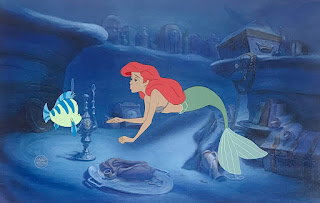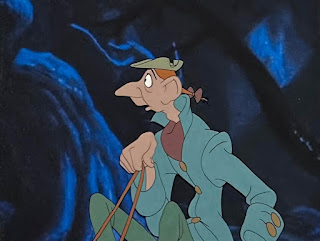Original hand painted production animation cels of Merlin, Wart, and Sir Ector from "The Sword In The Stone," 1963, Walt Disney Studios; Merlin and Sir Ector numbered 32 in ink lower right; Set on an original hand painted master production background with matching line overlay cel; Size - Merlin, Wart, & Sir Ector: 9 x 10 1/4", Image 11 1/2 x 15 3/4"; Unframed.
"The
Sword in the Stone," 1963 is the 18th full length feature film produced
by Walt Disney and it was released on December 25, 1963 by Buena Vista
Distribution. The film was based on the novel of the same name, that was
first published in 1938. It was later republished in 1958 as the first
book of T. H. White's tetralogy "The Once and Future King." It was to be
the final Disney animated film released before Walt Disney's death on
December 15, 1966. The songs in the film were written and composed by
the Sherman Brothers, who would become very famous for their future work
on later Disney films including; "Mary Poppins," 1964, "The Jungle
Book," 1967, and "Bedknobs and Broomsticks," 1971.
Merlin
is a very powerful wizard with a pet owl named Archimedes. He befriends
and becomes the teacher of a 12-year old orphan named Arthur, who goes
by the name of Wart. Merlin is first seen living in a forest cottage,
and he believes in the philosophy of "Brain over Brawn." As a wizard, he
is very intelligent, has a wide variety of powers, and is considered
the most powerful wizard in the world. He has the ability to see into
the future, and has the ability to shape-shift. Merlin was animated by
Milt Kahl, Frank Thomas, and Ollie Johnston; and voiced by Karl Swenson
who was an American theater, radio, film, and television actor.
Wart
was animated by both Frank Thomas and Ollie Johnston; and the voice was
provided by three different actors; Rickie Sorensen, Richard Reitherman
and his brother Robert Reitherman. This lead to noticeable changes in
the character's voice between scenes. Also, the three voices all have
Brooklyn-esque accents, which differed with the English setting for the
film and with the accents spoken by all other characters.
Sir Ector was animated by Milt Kahl and Eric Larson and voiced by the great Sebastian Cabot. Sir Ector was once a knight of Uther Pendragon, and at some point adapted the orphaned Arthur whom Ector and his son Kay now refers to as The Wart. Sir Ector does not know about Arthur's birthright, dotes on his birth son Sir Kay, and does not trust magic and therefore Merlin; who is incorrectly refers to as Marvin.
The cel Merlin and Sir Ector appears in the film with the following dialog:
Sir Ector: "You will, uh... yes, I must say, you... have me there, Marvin, Yes. Well, as you win. You're welcome to stay if you like.
Merlin: (magically reappears) "Thank you. You're very kind. Very generous, I must say."
Sir Ector: "Well, uh, all we can offer is room and board. Hard times, you know, Marvin, we'll put you up in the northwest tower. (points to an aged, damaged tower) That's the guest room. It's a bid drafty in the winter, but in this blazing hot weather, it's the best room in the house."
The cel of Wart is trimmed and applied to the cel of Merlin and Sir Ector, and appears in the famous scene when he is searching for a sword for step brother Sir Kay. Wart goes into an old churchyard and stumbles upon the Sword In The Stone.
The production background appears in the film with the following dialog:
Sir Ector: "That's three demerits for being late and three more for the fish story. Now hop into the kitchen!"
Sir Kay: "I told you the Wart was loony."
Sir Ector: "Yes, well, he's either out of his head or, uh... there's something mighty fishy going on around here."
Original hand painted master production background with matching line overlay cel without the cels.
This is a great original production animation cel setup of Merlin, Wart, and Sir Ector all set on an original hand painted master production background with matching line overlay cel. All three characters are eyes open and full figure, and master production backgrounds from "The Sword In The Stone" are extremely rare to the open market. Merlin does have some paint cracking in his white hair and beard. An absolutely wonderful piece of original animation artwork perfect for any collection!
















